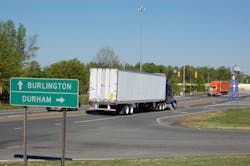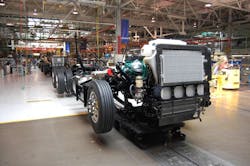The final Phase 2 greenhouse gas (GHG) rules governing heavy-duty trucks and engines issued today by the Environmental Protection Agency (EPA) and National Highway Traffic Safety Administration (NHTSA) — a rule that covers 1,690 pages — will seek to tighten down carbon emissions and boost fuel economy, as well as "clarify" the classification of natural gas engines and other gaseous-fueled heavy-duty engines.
The rule, which in the main is being welcomed by OEMs and suppliers, will regulate four "official" categories of heavy-duty vehicles and related equipment: combination tractors; trailers used in combination with those tractors; heavy-duty pickup trucks and vans; and vocational vehicles.
The rule also includes separate standards for the engines that power combination tractors and vocational vehicles, with EPA-specific hydrofluorocarbon standards to control leakage from air conditioning systems in vocational vehicles.
A 1,116-page analysis promulgated by NHTSA expects that the new rule will provide between $117.3 billion to $196.5 billion worth of net lifetime vehicle savings for 2018-2019 model year vehicles, the bulk of which will come from fuel savings: estimated to range between $79.7 billion to $149.1 billion in lifecycle savings.
In terms of annual savings, NHTSA projects the trucking industry as a whole should save somewhere between $7.8 billion to $8.5 billion per year due to the Phase 2 GHG rules.
Both agencies tap into a complicated greenhouse gas emissions model (GEM) to calculate those projected savings, developed to measure compliance with the new Phase 2 rule.The new Phase 2 rules also include certain “EPA-specific provisions” relating to controlling emissions relating to the use of diesel-powered auxiliary power units (APUs) installed in new tractors as well as non-GHG pollutants from light-duty motor vehicles, marine diesel engines, and other non-road engines and equipment.
Under this new rule, EPA is also requiring that engines from donor vehicles installed in glider kits meet the emission standards applicable in the year of assembly for said glider kits – including all applicable standards for “criteria pollutants,” with limited exceptions for small businesses and for other special circumstances.
Several industry observers noted that compliance with the initial Phase 1 rule by both OEMs and suppliers still isn’t finished as of yet and warn not to underestimate the challenges involved to comply with the new Phase 2 package.
“Today’s final rules establish a bold challenge to further increase fuel efficiency and reduce greenhouse gas emissions to unprecedented levels from a wide range of commercial vehicles,” said Allen Schaeffer, executive director of the Diesel Technology Forum (DTF), in a statement.
“The demands on heavy-duty engine and truck manufacturers are numerous,” he stressed. “In addition to compliance with these new fuel economy and greenhouse gas emissions requirements on a wide variety of customizable products, they must ensure near zero emissions performance for at least 435,000 miles.”
Schaeffer added that doesn’t lessen the need for commercial vehicles to “meet all the latest federal safety requirements and have the highest uptime and reliability, [with] the largest trucks must be able to move 80,000 pounds up mountains at 60 MPH, run 100,000 to 120,000 miles a year, in every corner of the U.S., while doing it all at the lowest possible cost.”
He pointed out that meeting the challenges set forth in the first phase of GHG rules has been underway since 2014, and won’t be fully implemented until 2017.
“In the days ahead we will be fully reviewing and offering additional insights on this new complex rule, and are hopeful that the new goals established here achieve an effective balance of meeting customer demands and societal goals,” Schaeffer emphasized.
Yet the Heavy Duty Fuel Efficiency Leadership Group – an informal alliance formed six years ago between six heavy-duty fleets, manufacturers and logistics companies – is one consortium that “looks forward to even more progress” on efficiency and emissions reductions for the heavy-duty vehicle sector due the Phase 2 rules.
“We’ve long supported standards that reduce emissions and improve the environment, particularly in the communities where we operate,” noted David Steiner, CEO of Waste Management, in a statement. “That’s why we support the new Phase 2 standards for medium and heavy-duty trucks. It’s a win-win for our industry, our customers and communities – reducing emissions and saving fuel and money.”
About the Author
Sean Kilcarr
Editor in Chief
Sean Kilcarr is a former longtime FleetOwner senior editor who wrote for the publication from 2000 to 2018. He served as editor-in-chief from 2017 to 2018.

